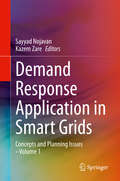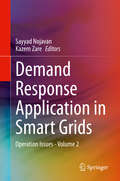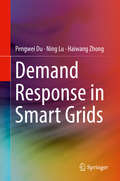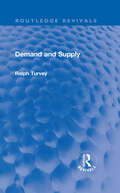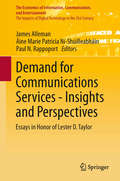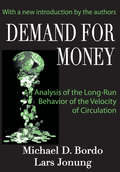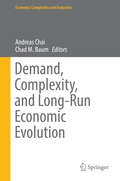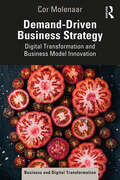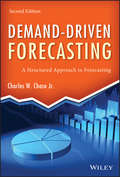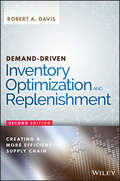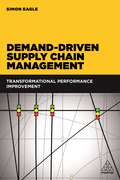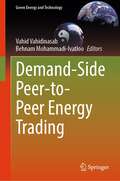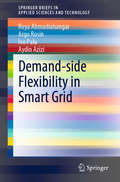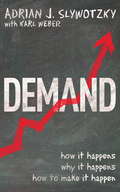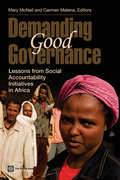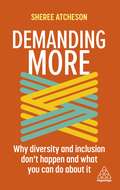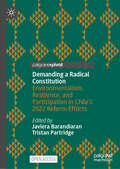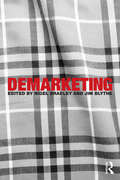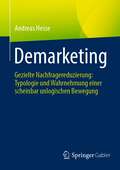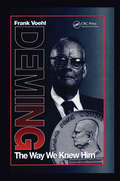- Table View
- List View
Demand Media
by John Deighton Leora KornfeldGoogle search had helped Demand Media grow to be a $1.9 billion online publisher. Then, social media and smartphone apps began to change the way people navigated the Internet. How should Demand Media respond? The business ran on a radically new model in which a stable of 10,000 freelance contributors supplied content, the Internet's search engines brought it 75 million readers each month, and advertising generated revenue. It took the guesswork out of content production, with algorithms that indicated which topics were being searched and created content accordingly. Demand treated its 5,000 online articles published per day as an investment, not a cost, a reversal of the traditional media model. In addition to being able to infer consumers' interests with its algorithm, the company had a formula for estimating the lifetime value of each piece of content. As the business models of print and broadcast media declined, Demand had figured out how to leverage digital and social media tools to bring down the costs of creating content and to find an audience. In spring 2011, executives at the five-year-old company were pleased with the company's billion dollar IPO, the biggest Internet IPO since Google's, but changes in consumer behavior on the Internet were obliging a review of the model.
Demand Prediction in Retail: A Practical Guide to Leverage Data and Predictive Analytics (Springer Series in Supply Chain Management #14)
by Maxime C. Cohen Paul-Emile Gras Arthur Pentecoste Renyu ZhangFrom data collection to evaluation and visualization of prediction results, this book provides a comprehensive overview of the process of predicting demand for retailers. Each step is illustrated with the relevant code and implementation details to demystify how historical data can be leveraged to predict future demand. The tools and methods presented can be applied to most retail settings, both online and brick-and-mortar, such as fashion, electronics, groceries, and furniture. This book is intended to help students in business analytics and data scientists better master how to leverage data for predicting demand in retail applications. It can also be used as a guide for supply chain practitioners who are interested in predicting demand. It enables readers to understand how to leverage data to predict future demand, how to clean and pre-process the data to make it suitable for predictive analytics, what the common caveats are in terms of implementation and how to assess prediction accuracy.
Demand Response Application in Smart Grids: Concepts and Planning Issues - Volume 1
by Sayyad Nojavan Kazem ZareThis book analyzes the economic and technical effects of demand response programs in smart grids. A variety of operational and financial benefits are offered by demand response programs (DRPs) for load-serving entities, grid operators, and electricity consumers. The most notable advantages of DRPs are presented in this book, including decreased electricity prices, risk management, market power mitigation, and flexibility of market operations. In-depth chapters discuss the integration of demand response programs for the planning and operation of smart grids and explore the uncertainties of market prices, renewable resources and intermittent load management, making this a useful reference for a variety of different organizations and players in the electricity market, such as reliability organizations, distribution companies, transmission companies, and electric end-users.
Demand Response Application in Smart Grids: Operation Issues - Volume 2
by Sayyad Nojavan Kazem ZareThis book analyzes issues surrounding the efficient integration of demand response programs (DRPs) on operation problems in smart grids. The benefits offered by demand response programs (DRPs) for load-serving entities, grid operators, and electricity consumers are explained, including decreased electricity prices and risk management. In-depth chapters discuss the flexibility of market operations, market power mitigation, and environmental benefits—making this a must-have reference for engineers and related practicing professionals working for organizations in the electricity market, including reliability organizations, distribution companies, transmission companies, and electric end-users.
Demand Response in Smart Grids
by Ning Lu Pengwei Du Haiwang ZhongThis book is the first of its kind to comprehensively describe the principles of demand response. This allows consumers to play a significant role in the operation of the electric grid by reducing or shifting their electricity usage in response to the grid reliability need, time-based rates or other forms of financial incentives. The main contents of the book include modeling of demand response resources, incentive design, scheduling and dispatch algorithms, and impacts on grid operation and planning. Through case studies and illustrative examples, the authors highlight and compare the advantages, disadvantages and benefits that demand response can have on grid operations and electricity market efficiency.First book of its kind to introduce the principles of demand response;Combines theory with real-world applications useful for both professionals and academic researchers;Covers demand response in the context of power system applications.
Demand Spillovers and the Collapse of Trade in the Global Recession
by Rudolfs Bems Kei-Mu Yi Robert C. JohnsonA report from the International Monetary Fund.
Demand and Supply (Routledge Revivals)
by Ralph TurveyFirst published in 1971, Demand and Supply is an introduction to the economics of resource allocation, often known as micro-economics. Ralph Turvey examines how the economy really works and does not just give the economists’ textbook version, which oversimplifies technology and exaggerates the importance of prices in adjusting supply and demand. Instead of offering theoretical diagrams and imaginary examples, he refrains from expounding those ideas that cannot be simply demonstrated or applied. But he includes sections on retail margins, urban land values, and the value of time – topics rarely dealt with in beginner’s books. Some examples of the examples are: university teachers’ pay; cotton spinning costs; pricing of tin cans; demand for farm tractors; newspaper economics; competition in the bus industry. This is the kind of economics used in practice and rests on down to earth fact finding. This book will be useful for both general readers and A- level and first year university students.
Demand for Communications Services - Insights and Perspectives
by James Alleman Áine Marie Patricia Ní-Shúilleabháin Paul N. RappoportThis volume grew out of a conference organized by James Alleman and Paul Rappoport, conducted on October 10, 2011 in Jackson Hole, Wyoming, in honor of the work of Lester D. Taylor, whose pioneering work in demand and market analysis has had profound implications on research across a wide spectrum of industries In his Prologue, Eli M. Noam notes that demand analysis in the information sector must recognize the "public good" characteristics of media products and networks, while taking into account the effects of interdependent user behavior; the strong cross-elasticities in a market; as well as the phenomenon of supply creating its own demand The second Prologue, by Timothy Tardiff and Daniel Levy, focuses more specifically on Taylor's body of work, in particular its practical applications and usefulness in analyses of, and practices within, the Information and Communications Technology (ICT) sector (known in Europe and elsewhere as the Telecommunications, Media, and Technology (TMT) sector) The remainder of the book is organized into four parts: Advances in Theory; Empirical Applications; Evidence-Based Policy Applications; and a final Conclusion The book closes with an Appendix by Sharon Levin and Stanford Levin detailing Taylor's contributions using bibliometrics. Not only featuring chapters from distinguished scholars in economics, applied sciences, and technology, this volume includes two contributions directly from Lester Taylor, providing unique insight into economics from a lifetime in the field. "What a worthy book! Every applied researcher in communications encounters Lester Taylor's work. Many empirical exercises in communications can trace their roots to Taylor's pioneering research and his thoughtful leadership. This book assembles an impressive set of contributors and contributions to honor Taylor. No surprise, the collection extends far and wide into many of the core topics of communications and media markets. The emphasis is where it should be-on important and novel research questions informed by useful data --Shane Greenstein, Professor of Management and Strategy, Kellogg School of Management, Northwestern University "For more than 40 years, Lester Taylor has been a leader in the application of consumer modeling, econometric techniques and microeconomic data to understand residential and business user behavior in telecommunications markets. During that time, he inspired a cadre of students and colleagues who applied this potent combination to address critical corporate and regulatory issues arising in the telecommunications sector. This volume collects the recent product of many of these same researchers and several other devotees who go beyond empirical analysis of fixed line service by extending Prof. Taylor's approach to the next wave of services and technologies. These contributions, including two new papers by Prof. Taylor, offer an opportunity for the next generation to learn from his work as it grapples with the pressing issues of consumer demand in the rapidly evolving digital economy. " -- Glenn Woroch, Adjunct Professor of Economics, University of California, Berkeley
Demand for EU Polity Building in the Shadow of the Russian Threat (Elements in European Politics)
by Ioana-Elena Oana Alexandru D. Moise Zbigniew TruchlewskiThe Russian invasion of Ukraine came on the heels of a series of crises that tested the resilience of the EU as a compound polity and arguably reshaped European policymaking at all levels. This Element investigates the effects of the invasion on public support for European polity building across four key policy domains: refugee policy, energy policy, foreign policy, and defence. It shows how support varies across four polity types (centralized, decentralized, pooled, reinsurance) stemming from a distinction between policy and polity support. In terms of the drivers of support and its evolution over time, performance evaluations and ideational factors appear as strong predictors, while perceived threat and economic vulnerability appear to matter less. Results show strong support for further resource pooling at the EU level in all domains that can lead to novel and differentiated forms of polity-building. This title is also available as Open Access on Cambridge Core.
Demand for Money: An Analysis of the Long-run Behavior of the Velocity of Circulation
by Lars JonungThe income velocity of money-an inverse measure of the demand for money balances-is the ratio of the money value of income to the average money stock that the public (excluding banks) holds in a given period. Why the magnitude of that ratio has changed over time is the subject of Michael D. Bordo and Lars Jonung's classic study, originally published as The Long-Run Behavior of the Velocity of Circulation. Supported by statistical data, econometric estimation techniques, and meticulous historical analysis, this work describes, in an international setting, how slow-moving economic, social, and political forces interact with the decisions households and firms make about how much money to hold.Annual time series of velocity for several countries from the late nineteenth century to the late twentieth century display a U-shaped pattern. Existing theories can explain each section of the velocity curve-the falling, flat, and rising parts-but the overall pattern is not consistent with any one theory. Here the authors put forth a comprehensive explanation for this behavior over time. Their theory is largely an extension of the approach of Knut Wicksell, the Swedish economist who stressed the role of substitution between monetary assets. This approach, which emphasizes institutional variables, is incorporated into the arguments for the traditional long-run money demand (velocity) function. Four types of empirical evidence strongly support the authors' theory: econometric studies of the long-run velocity function for several countries; a cross section study of approximately eighty countries in the postwar period; a case study of the Swedish monetization process in the fifty years before World War I; and an examination of the time series properties of velocity.Demand for Money suggests that institutional factors, as opposed to real income, play a greater role in velocity than previously thought. And these institutional factors have a major impact on monetary policy. This is a book that will prove of great value to economists, monetary strategists, and policymakers.
Demand, Complexity, and Long-Run Economic Evolution (Economic Complexity and Evolution)
by Andreas Chai Chad M. BaumThe purpose of this contributed volume is to consider how global consumption patterns will develop in the next few decades, and what the consequences of that development will be for the economy, policymakers, and society at large. In the long run, the extent to which economic growth translates into better living conditions strongly depends on how rising affluence and new technologies shape consumer preferences. The ongoing rise in household income in developing countries raises some important questions: Will consumption patterns always continue to expand in the same manner as we have witnessed in the previous two centuries? If not, how might things evolve differently? And what implications would such changes hold for not only our understanding of consumption behavior but also our pursuit of more sustainable societies?
Demand-Driven Business Strategy: Digital Transformation and Business Model Innovation (Business and Digital Transformation)
by Cor MolenaarDemand-Driven Business Strategy explains the ways of transforming business models from supply driven to demand driven through digital technologies and big data analytics. The book covers important topics such as digital leadership, the role of artificial intelligence, and platform firms and their role in business model transformation. Students are walked through the nature of supply- and demand-driven models and how organizations transform from one to the other. Theoretical insights are combined with real-world application through global case studies and examples from Amazon, Google, Uber, Volvo and Picnic. Chapter objectives and summaries provide consistent structure and aid learning, whilst reflective questions encourage further thought and discussion. Comprehensive and practical, this is an essential text for advanced undergraduate and postgraduate students studying strategic management, marketing, business innovation, consumer behavior, digital transformation and entrepreneurship.
Demand-Driven Forecasting
by Charles W. Chase Jr.Praise for Demand-Driven ForecastingA Structured Approach to Forecasting"There are authors of advanced forecasting books who take an academic approach to explaining forecast modeling that focuses on the construction of arcane algorithms and mathematical proof that are not very useful for forecasting practitioners. Then, there are other authors who take a general approach to explaining demand planning, but gloss over technical content required of modern forecasters. Neither of these approaches is well-suited for helping business forecasters critically identify the best demand data sources, effectively apply appropriate statistical forecasting methods, and properly design efficient demand planning processes. In Demand-Driven Forecasting, Chase fills this void in the literature and provides the reader with concise explanations for advanced statistical methods and credible business advice for improving ways to predict demand for products and services. Whether you are an experienced professional forecasting manager, or a novice forecast analyst, you will find this book a valuable resource for your professional development."--Daniel Kiely, Senior Manager, Epidemiology, Forecasting & Analytics, Celgene Corporation"Charlie Chase has given forecasters a clear, responsible approach for ending the timeless tug of war between the need for 'forecast rigor' and the call for greater inclusion of 'client judgment.' By advancing the use of 'domain knowledge' and hypothesis testing to enrich base-case forecasts, he has empowered professional forecasters to step up and impact their companies' business results favorably and profoundly, all the while enhancing the organizational stature of forecasters broadly."--Bob Woodard, Vice President, Global Consumer and Customer Insights, Campbell Soup Company
Demand-Driven Inventory Optimization and Replenishment
by Robert A. DavisUse demand driven optimized inventory and replenishment to overcome your supply chain weaknesses, and deliver business-maximizing results Reviewing the fundamentals of inventory optimization so that you can attain a demand-driven supply, Demand-Driven Inventory Optimization and Replenishment provides a business look at why present inventory systems sub-optimize the supply chain and faulty replenishment processes lead to wasted time and effort. Straightforward and clearly written, this book allows readers to come away with a good understanding of why optimized inventory and replenishment helps overcome in-system weaknesses and deliver results. Discusses how multi-echelon inventory optimization and replenishment enables installed systems to go from a sequential, "islands of efficiency" approach to a systematic distribution system working as a complete network Provides case studies throughout Reveals how optimized inventory and replenishment delivers results across industry verticals With a historical view of the three major supply chain efforts of the last thirty years, this book discusses mathematical shortcuts set up in the transitional and supply chain management systems that make it very difficult for companies to attain supply chain excellence.
Demand-Driven Supply Chain Management: Transformational Performance Improvement
by Simon EagleMany manufacturing and distribution companies are moving from the traditional 'forecast push MRP' to demand-driven supply chain management (SCM). Demand-driven SCM is an 'end-to-end' supply chain planning and replenishment process that enables companies to achieve their planned service levels from up to half the average level of inventory and requiring significantly less throughput capacity - irrespective of the level of demand volatility or lead-time length. Demand-Driven Supply Chain Management is the go-to source for industry supply chain/operations executives and students. It describes, in a readable but rigorous manner, the 'what, how and why' of the demand-driven SCM process. The key themes in the book are: what is demand-driven? why is demand-driven so effective? how to operate a demand-driven supply chain? and how to adopt the demand-driven process in your company? The book has been written in such a way that it doesn't require reading from cover to cover. Readers can quickly grasp the essential concepts from one of numerous self-contained sections that present the book's key concepts from different perspectives.
Demand-Side Peer-to-Peer Energy Trading (Green Energy and Technology)
by Behnam Mohammadi-Ivatloo Vahid VahidinasabDemand-Side Peer-to-Peer Energy Trading provides a comprehensive study of the latest developments in technology, protocols, implementation, and application of peer-to-peer and transactive energy concepts in energy systems and their role in worldwide energy evolution and decarbonization efforts. It presents practical aspects and approaches with evidence from applications to real-world energy systems through in-depth technical discussions, use cases, and examples. This multidisciplinary reference is suitable for researchers and industry stakeholders who focus on the field of energy systems and energy economics, as well as researchers and developers from different branches of engineering, energy, computer sciences, data, economic, and operation research fields.
Demand-side Flexibility in Smart Grid (SpringerBriefs in Applied Sciences and Technology)
by Aydin Azizi Roya Ahmadiahangar Argo Rosin Ivo PaluThis book highlights recent advances in the identification, prediction and exploitation of demand side (DS) flexibility and investigates new methods of predicting DS flexibility at various different power system (PS) levels. Renewable energy sources (RES) are characterized by volatile, partially unpredictable and mostly non-dispatchable generation. The main challenge in terms of integrating RES into power systems is their intermittency, which negatively affects the power balance. Addressing this challenge requires an increase in the available PS flexibility, which in turn requires accurate estimation of the available flexibility on the DS and aggregation solutions at the system level. This book discusses these issues and presents solutions for effectively tackling them.
Demand: Creating What People Love Before They Know They Want It
by Karl Weber Adrian Slywotzky Adrian Slywotzky With Karl WebDemand is one of the few economic terms almost everyone knows. Demand drives supply. When demand rises, it stimulates growth - jobs are created, the economy flourishes and society thrives. So goes the theory. It sounds simple, yet almost no one really understands demand, including the business owners, company leaders and policy makers who try to stimulate and satisfy it. DEMAND is a book with breakout general non-fiction potential which searches for clues as to where demand really comes from, and why, and how we might control it.
Demanding Good Governance: Lessons from Social Accountability Initiatives in Africa
by Carmen MalenaAccountability is the cornerstone of good governance. Unless public officials can be held to account, then critical benefits associated with good governance, such as social justice, poverty reduction and development remain elusive. The impacts of non-responsive and unaccountable governance are perhaps most harshly felt by the citizens of Africa, where corruption and governance failures are broadly acknowledged as a principal obstacle to the achievement Over the past decade, a range of social accountability practices-such as participatory budgeting, independent budget analysis, participatory monitoring of public expenditure and citizen evaluation of public services have been experimented with in many Africa countries. Their outcomes and lessons have, thus far, received little attend and documentation. This volume aims to make a contribution towards filling this gap by describing and analyzing a selection of social accountability initiatives from seven Sub-Saharan countries.
Demanding More: Why Diversity and Inclusion Don't Happen and What You Can Do About It
by Sheree AtchesonLook around you. Is your workplace as diverse and accepting as it should be? From accusations of racism in high political office, award-winning actors admitting the sets they work on aren't inclusive, to everyday occurrences of sexism, agism, racism and more, we are far from where we need to be. Demanding More is THE diversity and inclusion book you need to read. Moving beyond HR speak, this book clearly explains what diversity and inclusion are and what it means in the everyday experience of millions of people, both at work and in life. Sheree Atcheson, Global Director of Diversity, Equity and Inclusion at Peakon and ex Monzo, draws on her experience as a young woman of colour in an overly white male tech environment; she lives and breathes the issues she writes about. In Demanding More, she calls out the lack of awareness around privilege, unchecked and unconscious biases and details what intersectionality does to feelings of discrimination and disadvantage. Arguing that the best strategy for us all to adopt is allyship, where we all take ownership of the issues and stand up to bias or discrimination, this book will give us all tools and strategies to action every day, making us accountable to delivering change around us.
Demanding a Radical Constitution: Environmentalism, Resilience, and Participation in Chile’s 2022 Reform Efforts
by Javiera Barandiaran Tristan PartridgeThis open access book documents the critical thinking and political actions that generated one of the world’s most progressive national constitutions, presented to the Chilean public in 2022. Although that text was ultimately rejected in a national referendum, it drew on decades of diverse environmental, political, Indigenous, and community organizing and contained concepts and goals at the forefront of global efforts to create more just and equitable political systems, healthier living environments, and more resilient ecosystems. Drawing on research by faculty and students from the USA and Chile, chapters within this book address political memory, Indigenous representation, public participation, the Rights of Nature, environmental law, mining conflicts, natural commons, knowledge systems, and rural education. This book highlights important contributions from Chile’s 2022 reform efforts for diverse global responses to the erosion of democracy, environmental degradation, and climate change.
Demarketing
by Jim Blythe Nigel BradleyWe all understand the basic principles underpinning marketing activity: to identify unfulfilled needs and desires and boost demand for the solutions a product is offering. The mantra is always "sell more". De-marketing tries for the very opposite. Why would a company actively try to decrease demand? There are many good reasons to do so: a firm cannot supply large enough quantities, or wants to limit supply to a region of narrow profit margin. Or, crucially, to discourage undesirable customers: those that could be bad for brand reputation, or in the case of the finance sector, high risk. De-marketing can yield effective solutions to these issues, effectively curtailing demand yet (crucially) not destroying it. Nevertheless, the fundamental negativity of de-marketing strategies often causes organisations to hide them from view and, as a result, they are rarely studied. This then is the first book to cast light on the secretive, counterintuitive world of de-marketing, deconstructing its mysteries and demonstrating how to incorporate them into a profit-driven marketing plan. A selection of thought leaders in strategic marketing mix theory with illustrative global cases, providing insight into how these strategies have been employed in practice and measuring their successes and failures. It’s a must-read for any student or researcher that wants to think differently about marketing.
Demarketing Soda in New York City
by John A. Quelch Carin-Isabel Knoop Christine Snively Margaret RodriguezIn 2013, New York City Mayor Michael Bloomberg tried and failed to institute a ban on serving sizes of large sugary beverages. Obesity posed a large public health risk to the city. Mayor Bloomberg's proposed ban was one of many attempts to combat the rising threat of obesity. The case discusses the efficacy of the proposed ban on large soda serving sizes in the context of the other anti-obesity initiatives crafted by Bloomberg's administration.
Demarketing: Gezielte Nachfragereduzierung: Typologie und Wahrnehmung einer scheinbar unlogischen Bewegung
by Andreas HesseDieses Buch erläutert die riskante und subtile Strategie des Demarketings. Dabei wird Nachfrage nicht stimuliert, sondern durch verschiedene Maßnahmen gezielt reduziert oder umgelenkt. Die Beweggründe dafür sind unterschiedlich: Sowohl Nachhaltigkeit, soziale Verantwortung, Vertriebssteuerung und Image, als auch Effizienz, Umpositionierung oder schlichtweg Regulierungsvermeidung können Auslöser und Hintergrund sein. Der Autor zeigt strukturiert die verschiedenen Demarketingtypen auf und erläutert die Herangehensweisen und Konsumentenwahrnehmungen aus realen Kampagnen, wie beispielsweise der Marken Patagonia, Bio Company, Levi’s, Heineken, Gustavo Gusto oder KLM.Das erste grundlegende Werk zu Demarketing in deutscher Sprache – theoretisch fundiert und voller praxisrelevanter Hintergründe.
Deming The Way We Knew Him
by Frank VoehlPerhaps no other person in the history of modern business has so profoundly affected the methods of quality improvement in industry than W. Edwards Deming. The subject of many books, articles, and television documentaries, Dr. Deming has become the world-recognized leader of the quality movement in industry.


